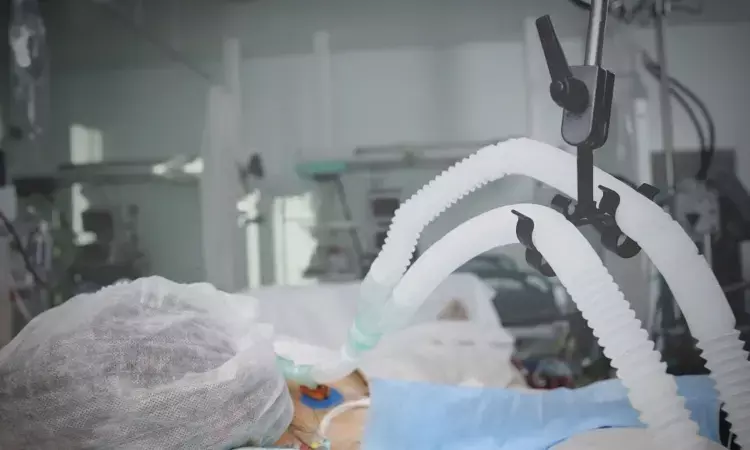- Home
- Medical news & Guidelines
- Anesthesiology
- Cardiology and CTVS
- Critical Care
- Dentistry
- Dermatology
- Diabetes and Endocrinology
- ENT
- Gastroenterology
- Medicine
- Nephrology
- Neurology
- Obstretics-Gynaecology
- Oncology
- Ophthalmology
- Orthopaedics
- Pediatrics-Neonatology
- Psychiatry
- Pulmonology
- Radiology
- Surgery
- Urology
- Laboratory Medicine
- Diet
- Nursing
- Paramedical
- Physiotherapy
- Health news
- Fact Check
- Bone Health Fact Check
- Brain Health Fact Check
- Cancer Related Fact Check
- Child Care Fact Check
- Dental and oral health fact check
- Diabetes and metabolic health fact check
- Diet and Nutrition Fact Check
- Eye and ENT Care Fact Check
- Fitness fact check
- Gut health fact check
- Heart health fact check
- Kidney health fact check
- Medical education fact check
- Men's health fact check
- Respiratory fact check
- Skin and hair care fact check
- Vaccine and Immunization fact check
- Women's health fact check
- AYUSH
- State News
- Andaman and Nicobar Islands
- Andhra Pradesh
- Arunachal Pradesh
- Assam
- Bihar
- Chandigarh
- Chattisgarh
- Dadra and Nagar Haveli
- Daman and Diu
- Delhi
- Goa
- Gujarat
- Haryana
- Himachal Pradesh
- Jammu & Kashmir
- Jharkhand
- Karnataka
- Kerala
- Ladakh
- Lakshadweep
- Madhya Pradesh
- Maharashtra
- Manipur
- Meghalaya
- Mizoram
- Nagaland
- Odisha
- Puducherry
- Punjab
- Rajasthan
- Sikkim
- Tamil Nadu
- Telangana
- Tripura
- Uttar Pradesh
- Uttrakhand
- West Bengal
- Medical Education
- Industry
Hospital acquired gram positive infections linked to increased mortality in cirrhosis patients admitted to ICU: Study

A recent study published in the recent issue of Annals of Intensive Care shed light on a previously overlooked area of hospital-acquired bloodstream infections in the ICU, especially for patients with cirrhosis.
This study was conducted across 101 centers and analyzed data from the Eurobact-2 international cohort study by encompassing a total of 1059 cases of hospital-acquired bloodstream infections. This study underlines the increased vulnerability of cirrhotic patients to infections contracted within hospital walls. Cirrhotic patients who accounted for 160 of the cases showed a distinctive epidemiological profile when compared to their non-cirrhotic counterparts.
The variance in infection sources was a crucial finding of this study. While non-cirrhotic patients predominantly suffered from pulmonary infections, cirrhotic patients were more susceptible to abdominal sources that hinted at underlying physiological factors that could possibly influence the infection localization.
Cirrhotic patients expressed a predilection for Gram-positive infections, notably Enterococcus faecium. The prevalence of this pathogen was significantly higher among the cirrhotic patients that underlined a potential association between cirrhosis and increased susceptibility to specific pathogens. The association between cirrhosis and Enterococcus faecium infections remained profound even after adjusting for confounding factors which highlighted the distinct microbial landscape within cirrhotic patients.
The study uncovered a concerning trend in mortality rates. Cirrhotic patients afflicted with hospital-acquired bloodstream infections faced a 30% higher risk of mortality when compared to their non-cirrhotic counterparts. This underlines the urgent need for tailored interventions and elevated surveillance protocols to reduce the impact of infections in this vulnerable population.
The findings emphasized the significance of this study in guiding clinical management strategies for critically ill cirrhotic patients. Understanding the unique epidemiological nuances of the infections in cirrhotic patients is critical in improving the patient outcomes and reducing mortality rates
The benefits of this study extend beyond the ICU which prompts a reevaluation of infection prevention and control measures in hospital settings. With increase in the prevalence of cirrhosis, proactive measures that target this high-risk population could yield substantial benefits in reducing the burden of hospital-acquired infections.
Source:
Wozniak, H., Tabah, A., Barbier, F., Ruckly, S., Loiodice, A., Akova, M., Leone, M., Conway Morris, A., Bassetti, M., Arvaniti, K., Ferrer, R., de Bus, L., Paiva, J. A., Bracht, H., Mikstacki, A., Alsisi, A., Valeanu, L., Prazak, J., … Timsit, J.-F. (2024). Hospital-acquired bloodstream infections in critically ill cirrhotic patients: a post-hoc analysis of the EUROBACT-2 international cohort study. In Annals of Intensive Care (Vol. 14, Issue 1). Springer Science and Business Media LLC. https://doi.org/10.1186/s13613-024-01299-x
Neuroscience Masters graduate
Jacinthlyn Sylvia, a Neuroscience Master's graduate from Chennai has worked extensively in deciphering the neurobiology of cognition and motor control in aging. She also has spread-out exposure to Neurosurgery from her Bachelor’s. She is currently involved in active Neuro-Oncology research. She is an upcoming neuroscientist with a fiery passion for writing. Her news cover at Medical Dialogues feature recent discoveries and updates from the healthcare and biomedical research fields. She can be reached at editorial@medicaldialogues.in
Dr Kamal Kant Kohli-MBBS, DTCD- a chest specialist with more than 30 years of practice and a flair for writing clinical articles, Dr Kamal Kant Kohli joined Medical Dialogues as a Chief Editor of Medical News. Besides writing articles, as an editor, he proofreads and verifies all the medical content published on Medical Dialogues including those coming from journals, studies,medical conferences,guidelines etc. Email: drkohli@medicaldialogues.in. Contact no. 011-43720751


